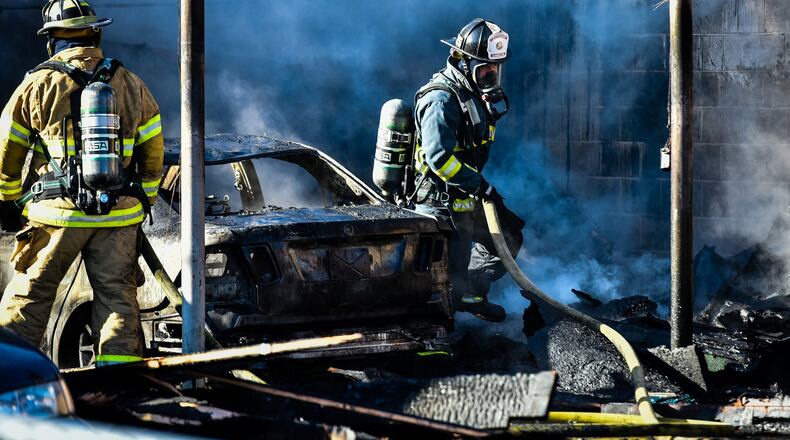Union contracts will focus a lot around compensation in the next few years, said Michael Franczak, executive manager of the Federal Mediation and Conciliation Service Great Lakes District. He said salaries and job security among declining tax revenues are some of the biggest issues.
“What does that mean for public safety, and the ability for school districts to meet student needs in these unprecedented times,” said Franczak, a graduate of both Miami University in Oxford and Ohio State University. “I think the biggest piece is how are unions and employers going to handle, first the staffing, the pay, the job security and ensuring the public needs are met, whether that is police, fire or teachers in terms of public safety or educational opportunities for kids.”
LOCAL NEWS: Crowd marches through downtown Middletown in latest Butler County protest
Many local police and fire unions will negotiate new contracts in the coming months. Hamilton’s IAFF union will restart negotiations in fall 2021 and Hamilton’s police union contract expires this February. Fairfield and the city fire union have restarted negotiations after a brief pause amid the COVID-19 pandemic, city officials said.
Former Miami University Department of Management associate professor David Walsh said severe local government budgetary issues caused by reduced tax revenues are only exacerbated by increased costs addressing the virus.
“This situation will make it more difficult to fund contract improvements,” Walsh said, adding he wouldn’t be surprised if public employers will press for pay or personnel cuts. “Issues of what should be done by public employers to ensure the safety of their employees will loom large, as will the question of whether or how long employees will be allowed to stay home if they do not feel safe.”
Walsh said health benefits covered in union contracts are likely to be bigger bargaining issues as he sees health insurance costs possibly rising.
Tony Harris, president of Hamilton’s International Association of Fire Fighters union, said Hamilton has “seen deep cuts” over the years, “and we’ve seen challenging staffing models that hopefully we’re coming out of now so we can properly do our jobs.” And not unlike many other area unions, Harris said, “When we see our community’s in a fight, we’re going to be fighting right there with them.”
First responder unions could likely be addressing COVID-specific safety issues, from hazard pay, personal protection equipment and adequate supplies, Franczak said. He’s not aware of any COVID-specific language happening now in union negotiations but said “safety will be a continuing issue at the bargaining table.”
“I would imagine there would be language in there that deals with safety protections, both internally and externally, for bargaining unit members,” he said.
Teachers were unexpectedly thrust into teaching online in the final months of the 2019-20 school year during the pandemic, and experts see teacher union contracts addressing issues like remote learning — which Franczak said could be in play if a second wave of the virus happens in the fall as some health experts have predicted. He said some districts will have a hybrid approach this fall with some in-class and some online instruction, but districts and teacher unions will have to prepare for online-only instruction.
The pandemic has brought on unique challenges for teachers, said University of Dayton education and law professor Charles Russo. They’re spending more time online as they’re learning a new teaching methodology, and they’re spending more time preparing for remote learning. But they’re also using personal resources — home internet and personal printers and scanners — to do their jobs.
LOCAL NEWS: Protesters kneel, chant in downtown Hamilton for city’s second event after George Floyd’s death
“I think it would be fair to have an educator to have some of those expenses paid for,” Russo said. Teachers currently personally buy some supplies for their classrooms and only a certain percentage is reimbursed by districts.
A stipend for internet and equipment like a printer and scanner could be addressed in union contracts, he said, but believes schools, which have bulk-buying power, could supply some equipment for remote learning.
But the bottom line, Russo said, is that both sides will have to do “what’s best for the kids, as opposed to what the boards want, as opposed to what the teachers want.”
“Union negotiations can get often times get acrimonious,” Russo said. “Right now, both sides have to realize that this is a bigger problem than all of us and if the money’s not there, people are going to have to be reasonable.”
Unions and management may also have to develop a longer-term strategy as the country is “entering a brave new world,” he said.
“I think the impact here — I won’t say long-lasting, but it’s going to be longer-lasting than other problems we’ve had,” Russo said. “I think they have to think about what this means over the next three to five to seven years in getting things back on par. How can they reach reasonable compromises without compromising the quality of the education while being fair to employees and serving kids well?”
About the Author

